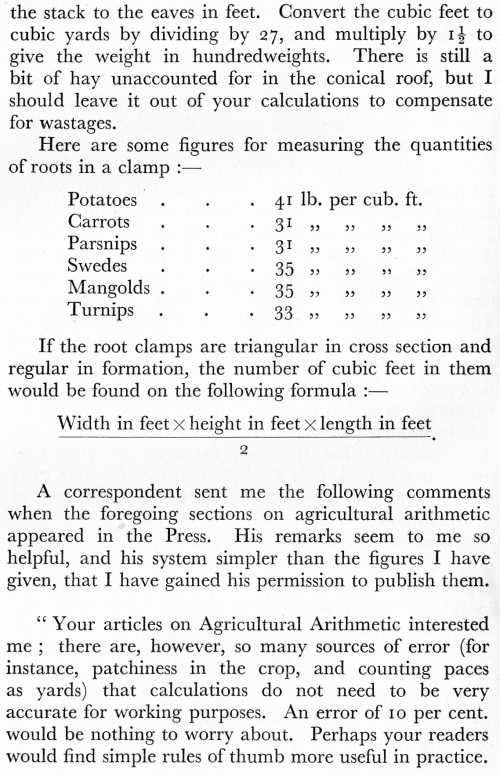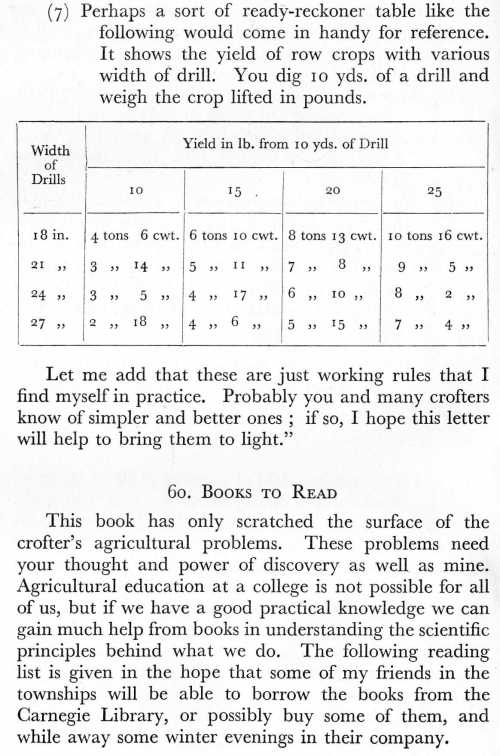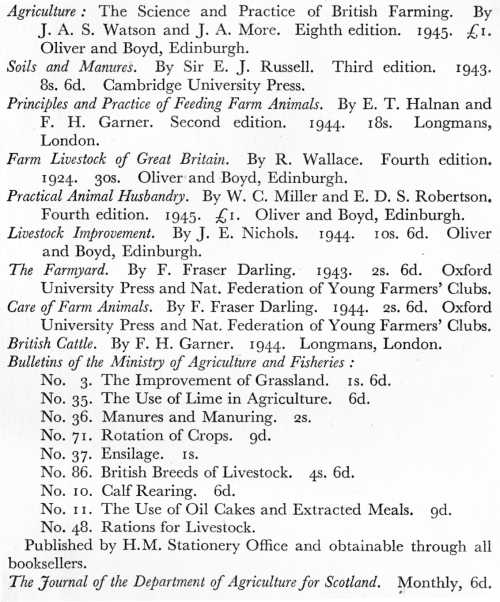|
58. Calculating Manuring for Root Crops
It struck me, when pacing out a garden the other day to
determine the amount of lime to be applied, that a few figures and constants
might be useful to keep for reference. Crofters deal with small acreages and
often enough with fractions of an acre, so that when it comes to applying
dressings of a concentrated manure it is most necessary to have calculations
accurate. And this not only for the sake of economy of use, but for the
welfare of the plant to be dressed ; a too heavy dressing may kill the crop.
The first number to keep in mind is the number of square
yards in an acre. Nowadays, only the Imperial acre has any significance—4840
square yards. The Scottish acre of 6104 square yards might as well be
forgotten except for historical purposes.
Unfortunately, the figure 4840 does not give an easily
measured or remembered square root to enable us to plot an acre on the
square. Probably 70 yds. square is the best figure we can use for rough
purposes—giving 4900, or 80
x 60—giving
4800 sq. yds. An acre is also 10 sq. chains, a chain being 22 yds. long,
containing 100 links of 7.92 in. With a chain, therefore, acreage can be
rapidly computed, or an acre laid out by measuring 2 chains x 5. One chain
is a common width for the lands in ploughing, and in such pieces of ground
as allow the use of this width of a land it gives an easy guide to
measurement of acreage. When you have to rely on pacing for computing areas,
it is well to remember that
it needs a pretty good pace to make a yard, a good 6 in.
more than a pace in ordinary walking. I have taken the trouble myself to
check and practise making paces of a yard so that I can be fairly sure of
not being more than a foot or two out of true in a 100 yds. All the same, I
keep a 2-yd. and a 3-yd. stick in the barn, which are notched at intervals
of a foot, the first foot being marked in inches also and the second and
third foot in 3-in. intervals. These are most useful for marking out rows
during the spring work when the rows do not conform to the normal 27-in.
width made by a ridging plough. For example, carrots may be sown 15 to 16
in. apart, mangolds, swedes and early potatoes 24 in. and peas 36 in.
A useful point to remember is that a dressing of 1 ton
(2240 lb.) to the acre means less than
½ lb.
to the square yard. How small a quantity then is needed per square yard of a
concentrated fertilizer like nitro-chalk where 1½
cwt. to the acre may be used—-just over ½
oz.! Such a small quantity gives little room for mistakes on a small
patch of ground.
It is best, I think, not to calculate such concentrated
manures in quantities per square yard but in terms of yards of crop, where
this may have been sown in rows. The large farmer, for example, dressing his
potatoes with 3 cwt. of superphosphate to the acre, will be sowing the
fertilizer in standard drills of 27 in. This width equals
¾ yd.
and gives for all practical purposes 6450 lineal yards of crop to the acre:
3364 / 6450 = 0.052, or
that is, 4/5 oz. per yard of crop. Our 1½
cwt. of nitro-chalk which gave between ½
and 3/5 oz. per square yard when broadcast would give 2/5 oz. per lineal
yard of crop if applied to the drills. In row-crop work it is obviously an
economy to apply fertilizer to the drills where it is required and not to
the weeds between the drills.
Early potatoes would be planted only 2 ft. apart, which
would mean 7260 lineal yards of crop per acre instead of 6450 yds. of
standard drills. Therefore, the standard dressing of 3 cwt. of
superphosphates would have to be increased to the relation of 7260
/ 6450 = 1.13, which is a useful factor if you are
dealing with a biggish acreage, but for small patches it would be better to
stick to the quantity per yard of crop. Here is a field example : say we
have ten rows of early potatoes, 2 ft. apart and 57 yds. long ; that gives
570 yds. of crop at 4/5 oz. per yard of superphosphate at the rate of 3 cwt.
to the acre = 570 x 4/5 x 1/16 =
31 lb.
59. Calculating Yields and Quantities
From the figures given in the preceding section, it
should be easy to work out the number of lineal yards of crop per acre with
varying widths of row and calculate dressings of fertilizers for small
areas. There remains the estimate of yield by weighing the crop from average
stretches of the rows. When the rows are the standard 27 in. apart, a yield
of 1 lb. per lineal yard gives a yield per acre of 2 tons, 17 cwt., 2 qrs.,
13 lb. Thus, supposing a good average crop of potatoes gave 3 lb. per lineal
yard, the yield per acre would be three times the figure given above,
namely, 8 tons, 12 cwt., 3 qrs., 11 lb. to the acre.
Obviously, the narrower the distances between the rows
the higher would the acre yield be, calculated from the yield of
representative lineal yard stretches, and vice versa. Thus, if the
rows were 2 ft. apart the yield per acre from 1 lb. per lineal yard would be
5 cwt., 3 qrs., 1 lb. more than for the standard drill of 27 in., making a
total per acre of 3 tons, 3 cwt., 2 qrs.; and if the rows were 30 in. apart
the yield per acre would be 2 tons, 11 cwt., 3 qrs., 12 lb.
In giving these figures per lineal yard, do not let it be
thought that I suggest that crop yields should be calculated from separate
measured yards, because a very slight error in the yield of 1 yd. would be
enormously exaggerated when reckoned per acre. Representative stretches of
10 yds. should give moderate accuracy, and they should be measured, not
paced.
The estimation of yields and quantities required for the
normal working of the croft certainly adds to the interest of the work. I
always like to work on the basis of a winter period of 200 days, that is
from 20th October to 8th May, and allow a cow 14 lb. of hay a day for that
period. There are 160 stones in a ton, so the cow's ration should be 25 cwt.
for the winter. If sheaves are fed for part of the time, adjustment must be
made on this figure. I should like my cows to have 42 lb. of roots a day for
the period, roots being widely interpreted to include such green fodder as
kale. A cow, therefore, would consume 600 stones or 3 tons, 15 cwt. of roots
in the season. Unfortunately, my poor cows never do get this quantity ! But
it is not excessive by dairy cow standards— indeed,
it is hardly adequate—but our cows are smaller than down-country cattle and
do not give the quantity of milk.
Measurement of the quantity of hay one has won is quite
difficult because our stacks are small, and often round, and its texture may
not be representative of hay in other districts where measurement for buying
and selling is common. The standard East Lothian measure is that a cubic
yard weighs 14 stones = 1 ¾
cwt. West Highland hay in small circular stacks would probably weigh 1½
cwt.
The contents of a circular stack may be measured by
squaring the average girth in feet and multiplying by 0.07958; multiply the
resulting figure by the height of



 |

